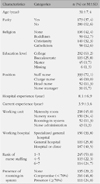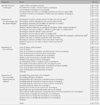Abstract
Purpose
This study was done to examine the attitude and awareness of nurses about rooming-in for new mothers and their infants.
Methods
Data were collected from 462 nurses from 40 hospitals from August 10 to September 20, 2008 using a questionnaire, and the collected data were analyzed using descriptive statistics, t-test and ANOVA.
Results
The mean score for attitude and awareness of nurses about rooming-in was 3.02 (range=2.13~3.80), which indicates that the nurses had positive opinions of the system. The factors with the highest and lowest scores were awareness of a successful implementation method (mean=3.35) and awareness of the advantages and disadvantages of the system (mean=2.73), respectively. The attitude and awareness of nurses about rooming-in differed significantly with age, religion, education level, parity, type of hospital, hospital nurse staffing grade (bed-to-nurse ratio), and presence of a rooming-in system.
Conclusion
This results of the study show that attitudes and awareness of nurses to rooming-in differed significantly according to personal factors (age, parity, religion, educational level) and work characteristics (hospital type, hospital nurse staffing grade, presence of rooming-in system). These findings can be used as basic data in determining optimal strategies for a system of rooming-in in the future.
Figures and Tables
References
1. Ann Y.M., Lee Y.E. A comparative study on the perceptions of the rooming-in system among nurses, physicians and mothers. Journal of the Korean Society of Maternal and Child Health. 1998. 2(2):239–261.
2. Buchan J., Bretherton T., Bearfield S., Jackson S. Stable but critical: The working conditions of Victorian public sector nurses in 2003. 2004. Retrieved September 1, 2006. from
http://www.acirrt.com.
3. Bystrova K, Ivanova V, Edhborg M, Matthiesen A, Ransjö-Arvidson A.B., Mukhamedrakhimov R, et al. Early contact versus separation: Effects on mother-infant interaction one year later. Birth. 2009. 36(2):97–109.
4. Crenshaw J. Care Practice #6: No separation of mother and baby, with unlimited opportunities for breast feeding. The Journal of Perinatal Education. 2007. 16(3):39–43.
5. Cuttini M., Santo M.D., Kaldor K., Pavan C., Tonchella C. Rooming-in, breastfeeding and mothers' satisfaction in an Italian nursery. Journal of Reproductive and Infant Psychology. 1995. 13:41–46.
6. Kang N.M., Lee Y.H., Hyun T., Kim K.N. Breastfeeding encouragement and support of health professionals in the hospitals. Journal of Korean Academy of Women's Health Nursing. 2000. 6(3):348–357.
7. Keefe M.R. Comparison of neonatal nighttime sleepwake patterns in nursery versus rooming-in environments. Nursing Research. 1987. 36(3):140–144.
8. Kim K.A., Shin S.M., Lee K. Evaluation of the effect of BFHI (Baby-Friendly Hospital Initiative) developed by WHO/UNICEF. Korean Journal of Perinatology. 2005. 16(1):37–48.
9. Kim Y.M., Cho D.S., Cha B.H., Hur M.H., Oh H.S., Kim E.Y. A study of the health policy for the cesarean section rate reduction. 2007. Seoul: Eulji University university-industry cooperation · Management center for health promotion.
10. Kim Y.M., Jang H.Y., Jeong E.J., Kim E.Y., Kim J.S., Kim E.K. A Study Of The Improvement Of Neonatal Care System. 2008. Seoul: Hospital Nurses Association.
11. Levitt C.A., Kaczorowski J., Hanvey L., Avard D., Chance G.W. Breastfeeding policies and practices in Canadian hospitals providing maternity care. Canadian Medical Association Journal. 1996. 155(2):181–188.
12. Lim B.D., Park J.H., Lee S.W. Assessment of operational conditions of baby-friendly hospital initiative and promotion strategy. Journal of the Korean Society of Maternal and Child Health. 2003. 7(2):131–143.
13. Ministry for Health, Welfare and Family Affairs. National health insurance fee schedule book. 2009. Seoul: Ministry for Health, Welfare and Family Affairs.
14. Ministry for Health, Welfare and Family Affairs. Korea Health Industry Development Institute. Guidelines for hospital evaluation programme. 2009. Seoul: Korea Health Industry Development Institute.
15. Nelson E.A., Taylor B.J. International child care practices study: Infant sleeping environment. Early Human Development. 2001. 62:43–55.
16. Rice P.L. Rooming-in and cultural practices: Choice or constraint? Journal of Reproductive and Infant Psychology. 2000. 18(1):21–32.
17. Song J.E. A comparative study on the level of postpartum women's fatigue between rooming-in and non rooming-in groups. Korean Journal of Women Health Nursing. 2001. 7(3):241–255.
18. Baby-Friendly Hospital Initiative. UNICEF. 2009. Retrieved July 21, 2009. from
http://www.unicef.co.kr.
19. World Health Organization. Evidence for the 10 steps to successful breastfeeding (rev.ed., WHO/CHD/98.9). 1998. Geneva, Switzerland: Author.
20. Yamauchi Y., Yamanouchi I. The relationship between rooming-in/not rooming-in and breast-feeding variables. Acta Paediatrica Scandinavica. 1990. 79(11):1017–1022.




 PDF
PDF ePub
ePub Citation
Citation Print
Print




 XML Download
XML Download